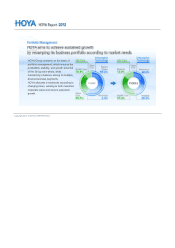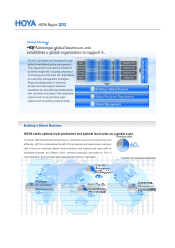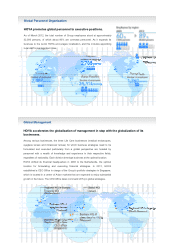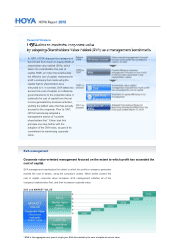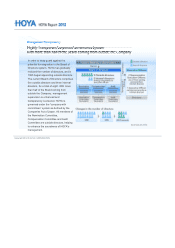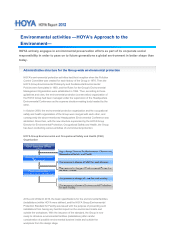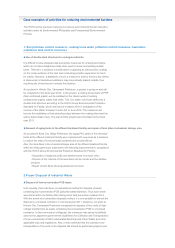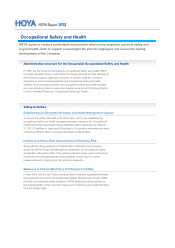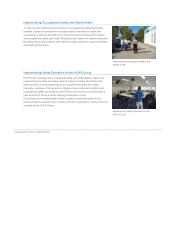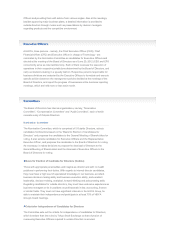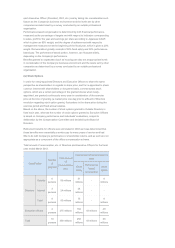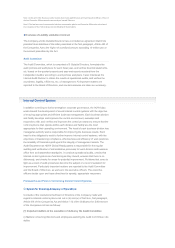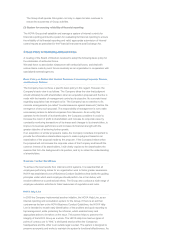Pentax 2012 Annual Report Download - page 28
Download and view the complete annual report
Please find page 28 of the 2012 Pentax annual report below. You can navigate through the pages in the report by either clicking on the pages listed below, or by using the keyword search tool below to find specific information within the annual report.
safely according to the preliminary agreements and in compliance with the Road
Traffic Act and other related laws and regulations. Thus, prior confirmation
between the parties concerned covered the operation procedure including that for
the purging of oil before the transportation, the safety management system to be
employed, the qualification of the workers, the emergency response when
necessary, etc., and the disposal was completed in April 2012.
The plant in Koka City, Shiga Prefecture outputted part of its industrial waste as
valuables and donated the profit on sale of them to the “Mother Lake Shiga
Campaign” site. The contribution was made twice in a year, which amounted to
¥239,016 in the first half of the fiscal year of 2011. The donated money will be
used in environmental projects related to Lake Biwa. A description of the
contribution was posted on the Internet web page of the Shiga Campaign Site.
The contact lens outlets “Eye City,” which are an operation of HOYA’s Eye Care
Division, have been carrying out the Eye City ECO Project since 2010. This
project aims to promote the recycling of the empty cases of the now-mainstream
disposable contact lenses recovered at 193 outlets of ours in Japan. The empty
plastic cases recovered by those retail outlets were sold to recycling contractors,
and the Division contributed the payment received for the sale plus the equal
amount of the HOYA donation to the Japan Eye Bank Association.
The total of the donations from April 2010 to September 2011 amounts to
¥1,223,560.
The recovery of the empty cases from this recycling activity amounts to 40.86
tons, which is equivalent to 128.71 tons of CO2 reductions. The area of forest
needed to absorb this amount of carbon dioxide is as wide as 5.6 Tokyo Domes.
As part of this recycling project, the aluminum seals on the empty plastic cases
are also recovered and sold to the recycling contractors.
According to the survey of the Eye City Net members in August 2011, 68 percent
of the members did not know that the empty cases of the disposable lenses can
be recycled. Yet, 75 percent of the members responded to the questionnaire that
they are willing to help the recycling by keeping the empty cases of the
disposable lenses. Thus the Eye City ECO Project is now an activity increasingly
appreciated and backed up by the Eye City Net members.
At our plant in Pyeongtaek City in Korea, the deionized water production line was
expanded to two systems in answer to the rise in the use of deionized water. Until
recently, the RO water* discharged from the process of deionized water
production had been disposed of as wastewater. However, the reuse of this water
in the newly added line is keeping the use of water at a limited level.
* RO (reverse osmosis) is a technique of causing a “reverse osmosis” by applying a large
pressure to a semipermeable membrane in opposition to the osmotic pressure. The RO water is
the water produced by the use of a reverse osmosis (RO) membrane.
The power supply in Japan today is precarious due to the shutdown of nuclear
power plants after the tsunami disaster. In consideration of the situation and with
●Donation of profit on sale of industrial waste
●Recycling of the empty cases of contact lenses
3. Efficient use of resources
● Recycling of water in deionized water production
4. Energy saving and power saving activities
● Installation of demand monitors and replacement of fluorescent lamps




